Examples and best-practice advice on implementing Google ad extensions
Ad Extensions are additional features that enhance, or extend, your AdWords ads. Options include call extensions - which add a phone number or ‘click-to-call’ button to your ads, sitelinks - which let you add links to other pages within your website, and location extensions – which can include a map marker.
There are various types of Ad Extensions and each has its own advantages, but in general the overall benefits of using Ad Extensions are:
- Ad Extensions are free. You only incur a pay per click amount, equivalent to a headline click, if someone engages with your ad.
- They make your ads more visible, because they take up more room in the SERPs.
- They help improve CTR, because they let you add valuable information about your products and services.
- They help improve Ad Rank: Google says “If two competing ads have the same bid and quality, then the ad with greater expected impact from extensions will generally appear in a higher ad position than the other.”
- Ad extensions can boost conversions, either by making it easier for customers to make a purchase, or by providing the extra information needed to convince a customer it’s time to buy.
- Better Quality Score: Ad extensions generally help to improve Quality Score, which means lower CPCs.
You can choose as many ad extensions as you like. However, you can’t choose when the extensions will appear. Google decides when, and if, to show ad extensions. However, if you don’t implement the extension, then it won’t show at all!
Sitelinks Extensions
Sitelinks can display up to six additional links as part of your search ads. These can only appear if your ad is in position #1 to #3.
These additional links need to point to different URLs than the ad’s main landing page, and each sitelink must have a unique URL.
You can specify a headline for each sitelink. Google also allows you to add an additional description for each sitelink, which it may or may not choose to display.
As well as giving you more visibility in search, sitelinks offer a valuable opportunity to cross-sell different products, or provide additional information to searchers who may not be ready to buy.
For instance, this ad from Nike uses sitelinks to direct customers to its skateboarding, running, women’s training and NIKEiD pages:
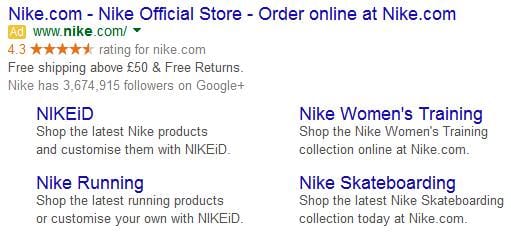
This Asda ad, meanwhile, directs customers to its ‘Click & Collect’ and delivery pages, as well as cross-selling various products:
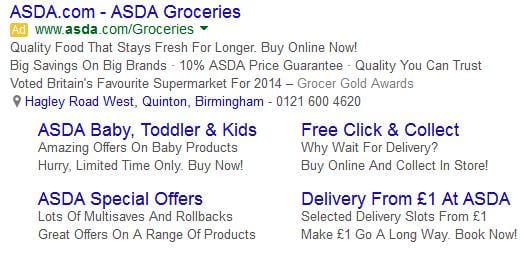
Sitelinks extensions can benefit any business. For example, a B2B business, which relies on building customer trust to secure leads, would be better off using sitelinks to direct users to informational pages that promote the business’s values, or make it easy for prospects to get in touch. Think ‘About Us’ pages, testimonials, accreditations and contact details.
An e-Commerce business might be better off using sitelinks to cross-sell products – for example, by linking to a baby food category page on an ad promoting nappies (diapers) – as well as promoting special offers and discounts.
Call Extensions
Call extensions make it easy for customers to contact you after viewing an AdWords ad. They let you add telephone numbers to desktop search ads, and ‘click-to-call’ buttons to mobile ads.
Click-to-call buttons allow mobile users to call you instantly by tapping the button. The cost per click is the same as a normal ad click.
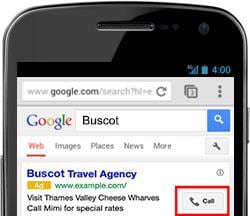
Image source: https://support.google.com/adwords/answer/2453991
Call extensions can appear within search ads in any position on the page.
Call extensions are important because they take a step out of the conversion process. If a customer likes to make enquiries or place orders by phone, call extensions give them a chance to do so without clicking through to your site.
This makes them particularly useful for B2B companies that use a lead generation model, retailers that get a high volume of phone enquiries, and businesses whose ads tend to drive lots of footfall in local branches.
Be aware that you will pay when a mobile user taps your click-to-call button. However, you pay the same as you would for a normal ad click – and your customer is more likely to convert because they’re speaking to a human being.
Callout Extensions
Not to be confused with call extensions, callout extensions work like bullet points. They let you add short snippets of additional information to ads.

Image source: https://support.google.com/adwords/answer/6079510
Unlike sitelinks, callout extensions are not clickable. They’re intended to give you more space to promote your business, beyond the usual character limits of ad text.
Those of us who have struggled with the 70 characters AdWords allows for ad text will appreciate the benefits of callout extensions.
Each callout gives you up to 25 characters to play with. And since you can include up to four callouts at account, campaign and ad group level, this adds up to a whole lot of extra space.
Google decides when to show callouts, and which callouts to show. The length of your callouts, their performance, and the order in which you enter them all factor into whether Google decides to display them.
Callout extensions can only appear on ads in positions #1 to #3.
Review Extensions
Review extensions let you add snippets of third-party reviews and testimonials to your ads. Again, it’s up to Google when these will be displayed.

Image source: https://support.google.com/adwords/answer/3236114
Review extensions are an effective way to build customer trust by incorporating positive third-party opinions into your ad content.
You can choose to feature an exact quote, or paraphrase a quote. Either way, you must provide a link to the original source.
Review extensions should not be confused with seller ratings, which display ‘review stars’, rather than text snippets.
Google says review extensions “can boost click-through rate by up to 10%”, so they’re highly recommended for any business that can source a trustworthy third-party review or testimonial.
Location Extensions
Location extensions display your business’s address and a phone number as part of your ad. They also display a map marker, so local customers can easily pinpoint your location.
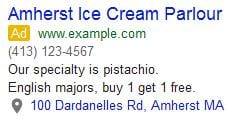
Image source: https://support.google.com/adwords/answer/2404182
You can choose to target consumers within a certain radius of the business location, and you can also set different bids depending on customers’ distance from this location.
Location extensions are designed to drive in-store visits. This makes them beneficial for businesses that operate bricks-and-mortar stores, but also advertise online.
On mobile devices, your ads will also display a link with directions to your business location. You can specify multiple locations by adding them to Google My Business.
Seller Ratings
Seller ratings are similar to review extensions, except they display star ratings instead of review snippets.
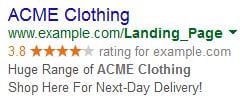
The rating displayed in your ads is an average all-time rating taken from several sources. These sources include Google Certified Shops, Google Consumer Surveys, and third-party review websites such as TrustPilot, Feefo and Reevoo.
To qualify for seller ratings, you need to consistently receive at least 30 customer ratings per month, and these ratings must average out at 3.5 or greater.
Seller ratings are enabled by default. You need to opt out if you don’t want seller ratings to be displayed. However, they will never appear for businesses who have an average rating below 3.5.
Third-party opinions build trust – so seller ratings are almost always a good idea. They can help to increase click-through rates and conversion rates, by making your ads and your business more attractive to customers.
Social Extensions
Social extensions show customers how many followers you have on Google+, as part of your search ads.

Image source: https://support.google.com/adwords/answer/1722132
For social extensions to display, your business needs to have a Google+ page. You can set this up using Google My Business. Your business also needs to have at least 100 followers on Google+, and to have posted recent, high-quality posts.
Social extensions show customers that you’re a large, trusted brand that engages with customers on social media. They help to build consumer trust and could help increase click-through rates.
Social extensions appear automatically, as long as you have a Google+ business page that’s linked to Google My Business – and you meet the criteria for having an ‘active’ presence on the social network.
Setting up and populating Ad Extensions does take time. However, the rewards can be great. They will not cost you more in your CPC rates and will certainly bolster your click-through rates and therefore your conversion rate and advertising ROI.
For more on how to use ad extensions to maximise on your campaigns read ClickThrough’s latest e-Book – The Best-Practice Guide to AdWords Audits: Part One. Download your copy now to find out more about staying competitive and relevant with regular audits.

Thanks to
Phil Robinson for sharing their advice and opinions in this post. Phil Robinson is the Founder of ClickThrough Marketing, a leading UK digital and search marketing agency specialising in helping companies increase leads and ecommerce sales. ClickThrough Marketing are Content Partners of Smart Insights. You can follow ClickThrough on
Twitter or connect with Phil on
LinkedIn.











 Thanks to
Thanks to 


